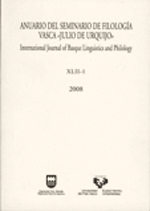Egitura kausatiboak euskaran, eslaboan eta erromantzean: konparaketa tipologiko baterantz
##plugins.themes.bootstrap3.article.main##
##plugins.themes.bootstrap3.article.sidebar##
Resumen
This article follows the wake of the author's previous articles regarding framework (typology) and study languages (Slavic, Romance and Basque), although on this occasion, the subject of relative clauses gives way to one of equal fascination: causativity.
The article is divided into two parts: in the first, some of the theoretical problems posed up to now are summarized (Bresnan 1982; Zubizarreta 1985; Baker 1988; Alsina 1992; Guasti 1998; López 2001). In the second part, starting from the morphological typology of causativity offered by Nedialkov & Silnitskii (1973) and collected by Moreno Cabrera (1991), the author establishes a list of similarities and differences among the languages analyzed regarding causativity. The most important similarity is that, evidently, in all languages, a valency increase occurs. We find the most important difference in the so-called "derivational morphological opposition", non-existing in the Romance languages (which choose the syntagmatic opposite), but present in Basque and the Slavic languages. In Basque, it means a single morpheme of maximum productivity; in the Slavic languages it means three morphemes in complementary distribution, which have a very scarce productivity since they are only applicable to a reduced list of verbs.
Unlike what occurs with the causative mood, the Slavic, Romance and Basque languages show a similar performance regarding the verbs of control and the permissive mood, ignoring a few peculiarities.
Cómo citar
##plugins.themes.bootstrap3.article.details##
Esta obra está bajo una licencia Creative Commons Atribución-NoComercial-SinDerivadas 4.0 Internacional.


